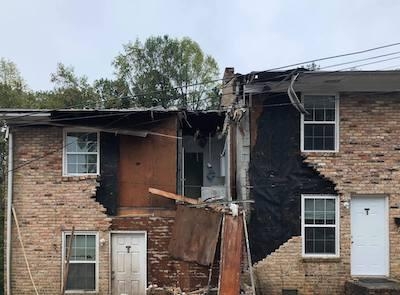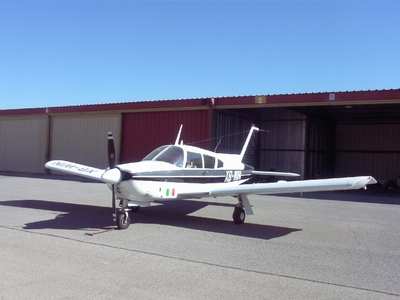Pilot Reported Failure Of A 'Vacuum Gauge' Prior To An In-Flight Breakup
The NTSB has released a preliminary report from an accident which occurred on October 30, 2019 at about 1032 eastern daylight time. A Piper PA-28R was destroyed following an inflight break up and impact with a residential building and terrain near DeKalb-Peachtree Airport (KPDK), Atlanta, Georgia. The commercial pilot and passenger were fatally injured. The airplane was privately owned and operated Instrument meteorological conditions prevailed at the time of the accident, and an instrument flight rules (IFR) flight plan was filed for the flight that originated at KPDK about 1014 and was destined for Mid-Carolina Regional Airport (KRUQ), Salisbury, North Carolina.

According to air traffic control communication and radar data provided by the FAA, the pilot established communication with the ground controller at PDK and advised that he had received Automatic Terminal Information Service Hotel (H). The 0953, weather observation included variable wind at 6 knots, visibility 6 miles with mist, with an overcast ceiling at 400 feet above ground level. Before departing, the pilot received an IFR release with instructions to fly a heading of 090°. The controller then cleared the flight for takeoff on runway 12L with a left turn to a heading of 090°, and advised the pilot the current winds were 150° at 5 knots.
The pilot established communication with the departure controller as he was climbing through 2,000 feet in a right turn to a heading of 090°. The controller instructed him to climb to 5,000 feet and proceed direct to the Athens (AHN) VORTAC. Additionally, the controller advised him of moderate precipitation extending to the east for 10 miles along their route of flight to AHN. The pilot began a right turn to the southeast and the controller instructed the pilot to turn left direct AHN, advising the pilot that it appeared that they were heading southbound. The pilot turned eastbound and the controller asked if they were showing a route direct to AHN, to which the pilot responded "affirmative." The airplane continued eastbound for approximately three miles before again turning southbound. The controller instructed the pilot to fly a heading of 090° and the pilot advised that they had "…lost their vacuum gauge." At that time the airplane was at 5,000 feet and turned to the northeast
briefly before it entered a right turn and rapidly descended to 3,700 feet. The controller instructed the pilot to maintain "wings level" and maintain 4,000 feet; however, the pilot did not respond. The controller made additional transmissions to the pilot to maintain wings level without a response, there were no additional communications with the flight, and radar contact was lost.
An examination of the accident site revealed the airplane impacted a residential apartment building 1.5 miles southeast of PDK. The airplane struck the wooden roof near the back wall, then continued through the second floor coming to rest in the kitchen area. The engine was located inside the apartment's crawl space and kitchen area, while the fuselage and cockpit remained outside of the residence back door. Additionally, the right main gear and sections of the rightwing flap were located on the second floor of the adjacent apartment. The debris field was about 790 feet in length on a magnetic heading of about 270° from the crash site. At the beginning of the debris field, a portion of the rightwing tip was located on the roof of another residential building. Within the debris field was a portion of the leftwing tip, right aileron, horizontal stabilizer and vertical stabilizer with the rudder attached by one hinge.

The engine remained attached to its mounts and the firewall. One of the three propeller blades were broken at the base of the propeller hub. All the propeller blades had scoring and impact marks throughout the span of the blades. The left wing aileron was not located during the initial search.
Flight control continuity was not confirmed, but flight control cable terminations were observed intact at the rudder pedal assembly in the cockpit. The aileron cable chain was fracture separated with one end still attached to the cable. The stabilator cables remained attached to the stabilator idler arm in the cockpit. The flap control cable remained attached to the flap selector handle. All the cables were separated between the cockpit controls and the control surfaces with signatures consistent with overload due to impact or cuts made to facilitate recovery of the wreckage.
The left wing spar inboard attach flanges were located at the accident site; a small section of the wing box which had separated from the main wreckage revealed a fracture of the lower spar cap that occurred on the outboard pair of attach bolts. The fracture surface was clean and smooth with no apparent indications of fatigue progression and exhibited damage signatures consistent with impacting the building. The outboard section of the left wing was separated chordwise at the main spar splice joint and the fractures were consistent with overload. It was located on the ground near the entrance gate to an apartment complex.
The right wing spar was located near the fuselage, it remained attached to the wing box. The outboard portion of the right wing was separated chordwise at the main spar splice joint and the fractures were consistent with overload. The outer section of the left wing was recovered from the roof of a residential building.
The stabilator's left and right tips were located in the debris field away from the fuselage. The center portion of the stabilator was impact damaged and separated chordwise about mid-span and the fractures were consistent with overload. The trim tab remained attached to the portions of the stabilator by its hinges. The forward spar of the stabilator was separated about 12" either side of the aircraft centerline. The center portion of the forward stabilator spar, including the balance tube and weight, remained attached to the tailcone bulkhead at its hinges.
The vertical stabilizer and rudder were separated from the tailcone and the fractures were consistent with overload. It was located along the debris field between the wing tips and the main wreckage. The rudder remained attached to the vertical stabilizer by its upper hinge. The rudder horn was separated from the rudder and the rudder cables remained attached to the horn. The rudder stops were intact and unremarkable.
The wreckage was recovered and retained for further examination.
According to FAA airmen records, the pilot held a commercial pilot certificate with ratings for airplane single-engine land, airplane multiengine land, and instrument airplane. At the time of the accident, the pilot held a third-class medical certificate issued on April 18, 2018 and reported 4,850 hours of flight experience.
(Images provided by the DeKalb County, GA Fire Department and from file. Not accident airplane)
 SpaceX to Launch Inversion RAY Reentry Vehicle in Fall
SpaceX to Launch Inversion RAY Reentry Vehicle in Fall Aero-News: Quote of the Day (04.23.24)
Aero-News: Quote of the Day (04.23.24) Aero-News: Quote of the Day (04.20.24)
Aero-News: Quote of the Day (04.20.24) ANN's Daily Aero-Linx (04.20.24)
ANN's Daily Aero-Linx (04.20.24) Aero-News: Quote of the Day (04.21.24)
Aero-News: Quote of the Day (04.21.24)




